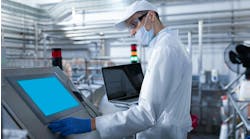Transforming the plant floor with digital data
"Old digital Neanderthals like me talk about digital transformation on the manufacturing floor, but young digital natives talk about digital transformation of the plant floor," said Dennis Hodges, CIO of Inteva Products, a large, global automotive supplier, mostly serving vehicle manufacturers. "To us, the Industrial Internet of Things (IIoT) is connected stuff—machines talking to machines, machines talking to people, and vice versa. IIoT includes data
management, applications, people, global networks and intelligent devices. The main question is what big project and purpose do we want it to do?"
Hodges and Jon Sobel, CEO and co-founder, Sight Machine, presented "Impactful digital transformation on the manufacturing floor: what works and why" at the Smart Industry 2016 conference in Chicago. Purpose-built for discrete and process manufacturing, Sight Machine's analytics platform uses artificial intelligence, machine learning and advanced analytics to address quality and productivity challenges.
Hodges reported that, while global networks and security are important to many users, simple data management is not a topic that gets talked about a lot. "ERP gives a backflash view of the shop floor with help from XML and MES, but a lot of good data gets lost in various buckets.
“XML can be the worst data prison,” Hodges added. “MES can gather data on parts production and operating parameters, but devices have more information on operating and environmental parameters, such as how long it took to get to the right torque or operating temperature."
Bigger data
Hodges explained that big data technologies can give a more comprehensive view of shop-floor applications by getting out and getting closer to sensors and data acquisition systems. “This is where Sight Machine really helps us analyze data, get a physical and logical view of our plant, and build an analytics workbench," he said. "This lets the three most important people—the plant, corporate and machine operations managers—look at data from the perspective that each of them needs."
To make big data and its analytics work, however, Hodges added it's also vital to remove the walls between operations technology (OT) and information technology (IT), so companies can work as one. "We do this, too. When Inteva was spun off from Delphi and GM, our OT and IT were joined, and then we brought in quality and engineering people, too," he added. "This can change everything.
"Previously, all of these production systems had manual data entry, and only captured partial data and production points,” added Sobel. “Now we're capturing backend machine temperatures, oil pressures, extruder flows and pressures, and other parameters.” This information is sent from the extruder via its RS232 port to a local Sight Machine server on Inteva's plant floor for calculation and analysis, where the data is processed with Kepware software for bridging hardware and software applications and with a REST JSON API, which can take data in any form, run it though Sight Machine's software engine, and send it via TCP/IP up to the cloud.
The triple acronym includes representational state transfer (REST) web services for interoperability between computer systems on the Internet; JavaScript Object Notation (JSON) open-standard format that uses human-readable text to transmit data objects; and application program interface (API), which is a set of software routines, protocols and tools for building software applications.
"We can do calculations and analysis locally on the plant floor, or we can do it on the cloud with a service like Amazon Web Services of others," added Sobel.
“Previously, we had to do analysis after production, but now we're closer to real-time.” Inteva Products’ Dennis Hodges discussed how the company’s implementation of plant-floor analytics is improving productivity and profitability by delivering timely, role-based information to operational stakeholders.




